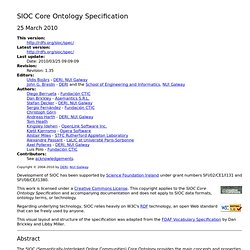

All Standards and Drafts. Terms for describing people. Abstract This document defines a set of terms for describing people.
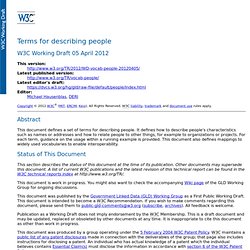
It defines how to describe people's characteristics such as names or addresses and how to relate people to other things, for example to organizations or projects. For each term, guidance on the usage within a running example is provided. This document also defines mappings to widely used vocabularies to enable interoperability. Status of This Document This section describes the status of this document at the time of its publication. This document is work in progress. This document was published by the Government Linked Data (GLD) Working Group as a First Public Working Draft. Publication as a Working Draft does not imply endorsement by the W3C Membership. This document was produced by a group operating under the 5 February 2004 W3C Patent Policy. Scope This document is aimed at both publishers and consumers of Linked Data. 1.
This section is non-normative. 1.1 Terminology source data publisher consumer 1.2 Conventions. BIO: A vocabulary for biographical information. Creators David Galbraith This document describes a vocabulary for describing biographical information about people, both living and dead.
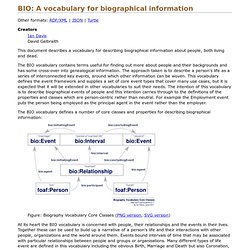
The BIO vocabulary contains terms useful for finding out more about people and their backgrounds and has some cross-over into genealogical information. The approach taken is to describe a person's life as a series of interconnected key events, around which other information can be woven. This vocabulary defines the event framework and supplies a set of core event types that cover many use cases, but it is expected that it will be extended in other vocabularies to suit their needs. The BIO vocabulary defines a number of core classes and properties for describing biographical information: Figure: Biography Vocabulary Core Classes (PNG version, SVG version) At its heart the BIO vocabulary is concerned with people, their relationships and the events in their lives.
Figure: Biography Vocabulary Timelines(PNG version, SVG version) History Namespace Term Summary. Ontology. An organization ontology. Last update: First released: Revision: Revision: 0.4 Editors: Dave Reynolds (Epimorphics Ltd) Copyright © 2010 Epimorphics Ltd This work is licensed under a Creative Commons License.
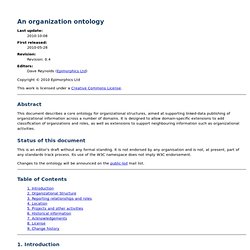
Abstract This document describes a core ontology for organizational structures, aimed at supporting linked-data publishing of organizational information across a number of domains. Status of this document This is an editor's draft without any formal standing. Changes to the ontology will be announced on the public-lod mail list. Table of Contents 1. This ontology was original motivated by a need to publish information relating to government organizational structure as part of the data.gov.uk initiative. The ontology gives minimal basic terms to support representation of: This coverage corresponds to the type of information typically found in organizational charts. The ontology does not provide category structures for organization type, organization purpose or roles. Overview of ontology Namespace Design notes.
FOAF Vocabulary Specification. Classes Class: foaf:Agent Agent - An agent (eg. person, group, software or physical artifact).
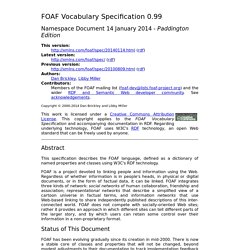
The Agent class is the class of agents; things that do stuff. A well known sub-class is Person, representing people. Other kinds of agents include Organization and Group. The Agent class is useful in a few places in FOAF where Person would have been overly specific. [#] [back to top] Class: foaf:Document Document - A document. The Document class represents those things which are, broadly conceived, 'documents'. The Image class is a sub-class of Document, since all images are documents.
We do not (currently) distinguish precisely between physical and electronic documents, or between copies of a work and the abstraction those copies embody. [#] [back to top] Class: foaf:Group Group - A class of Agents. The Group class represents a collection of individual agents (and may itself play the role of a Agent, ie. something that can perform actions). Here is an example. <! [#] [back to top] SIOC Core Ontology Specification. 25 March 2010 This version: Latest version: Last update: Date: 2010/03/25 09:09:09.
